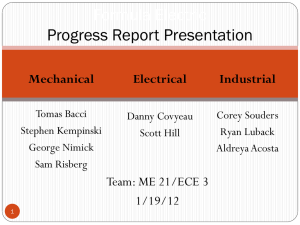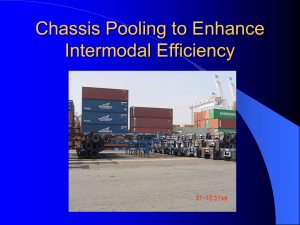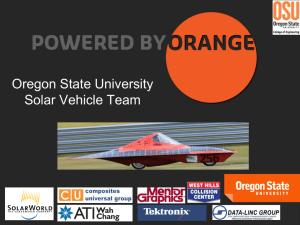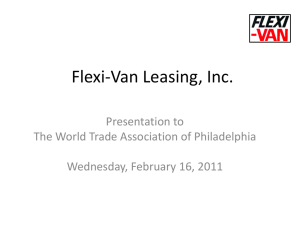Presented by
advertisement
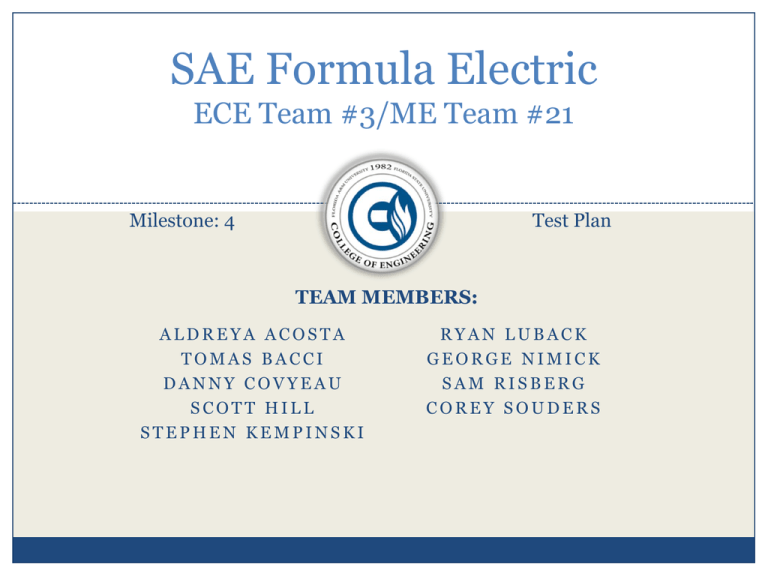
SAE Formula Electric ECE Team #3/ME Team #21 Milestone: 4 Test Plan TEAM MEMBERS: ALDREYA ACOSTA TOMAS BACCI DANNY COVYEAU SCOTT HILL STEPHEN KEMPINSKI RYAN LUBACK GEORGE NIMICK SAM RISBERG COREY SOUDERS Top Level Electrical System PRESENTED BY: DANNY COVYEAU Danny Covyeau 3 Agni 95-R Motor 4 Peak Efficiency: 93% Constant Torque: 42 Nm Continuous Output Power: 22 kW Weight: 24 lbs Popular, dependable choice among Formula Hybrid teams Danny Covyeau Kelly KD72501 Motor Controller 5 Optical Isolated: throttle potentiometer brake potentiometer switches Uses high power MOSFETs to achieve ~99% efficiency 200 Amps continuous 500 Amp peak for 1 minute Built in regenerative braking that can recapture up to 100 amps Still requires mechanical brakes Programmable controller with a user-friendly GUI * Courtesy Kelly KD User Manual Danny Covyeau Motor & Controller Testing 6 Objective: Verify that the electric motor controller works properly by testing that the forward and reverse functions of the motor operate Desired Result: The controller will be able to accelerate in both the forward and reverse directions Status: Controller has not been able to be programmed due to frequent resetting and under voltage warnings Next Step: Use a more powerful power supply (~80 VDC) to eliminate under voltage warnings and attempt to eliminate frequent resetting. Once the controller can be programmed the motor will be wired up. Danny Covyeau Controller Contingency Plan(s) 7 Kelly KDH07501A - $599 Optically isolated 24 – 72 VDC, 500A with Regen Kelly KDH12601E - $999 Optically isolated 12 – 120 VDC, 600A with Regen Both controllers eliminate the need for the isolation circuit Danny Covyeau Optoisolator Circuit Testing 8 LV Power 7805 Regulator Throttle 560 Ω Danny Covyeau Objectives: The LV and HV grounds have a minimum resistance of 40,000 ohms between them The output voltage of the circuit corresponds linearly with the input voltage of the circuit Test Plan: Use a low voltage variable DC power supply and a voltmeter to test the optoisolator circuit will be built. Desired Result: The input and output voltage of the throttle should vary from zero to five volts linearly. Speedometer Testing 9 • • Calibrated Using Sine Wave Generator Requires at least 500 pulses per mile from a Hall Effect Sensor • Status: – Tested Successfully Danny Covyeau Potbox Testing 10 Objective: To verify the proper operation of the throttle potentiometer (potbox). Test Plan: Attach potbox to 5 VDC power supply and verify that the output ranges between 0 and 5 volts using a voltmeter Desired Result: The potbox is expected to act as a simple voltage divider and deliver voltage levels that range from zero to five volts. The potbox must deliver a range of voltages between zero and five volts to be considered functional. Danny Covyeau Battery System, BMS, Other electrical components PRESENTED BY: SCOTT HILL Major Design Changes in Battery System 12 The following issues occurred in the ordering process of the batteries: Company (hobbyking.com) did not accept purchase orders and it was hard to communicate with them The team tried to order the batteries through a local hobby store and the markup was higher than the seller told us it would be so it was rejected. Two members of the team attempted to order the batteries themselves and be reimbursed. By the time the orders had been placed the batteries were on backorder and would be for about a month Scott Hill Major Design Changes in Battery System (Cont.) 13 • When the team found out that the batteries had been placed on backorder it was around late January and the timeframe of waiting on the backorder and shipping was not acceptable. • Alternatives were looked at through local retailers Battery Source and Fouraker Electronics. • Both companies could order through powersonic.com Scott Hill Battery Types Available 14 Lead Acid ( Various types) Pros: Low Price, Simple BMS needs, higher voltages easily obtained, longer lifetime than Li-Po Cons: More weight, lower discharge than desired Nickel-Metal Hydride Pros: Less weight, lower price than Li-Po batteries Cons: Lower voltage (more batteries required), lower discharge than desired Scott Hill New Battery Configuration 15 After looking at powersonic’s website a high rate series lead acid battery was found. Taking the higher weight into consideration and running the MATLAB simulation with the new estimated weight the team decided to go with a 36Ah battery. Scott Hill Battery Specs Battery Characteristics 16 Voltage 12V Capacity 36Ah Weight 26.6lbs Max Discharge Current (5s) 300A Max Short-Duration Discharge Current 660A Internal Resistance 13mΩ Max Charging Current 9.9A PHR-12150 High Rate Series Characteristics Lead Acid (High Rate Series) Nickel Cadmium Lithium Polymer Weight 159.6lbs 84.66lbs 30.6lbs Max Discharge Current 300A 320A 600A Number of Batteries 6 240 120 Scott Hill Cost per Battery $124.95 Unknown $8.95 BMS Changes 17 • BMS Requirements Li-Po Design Temperature monitoring per module Voltage monitoring per cell Lead Acid Design Temperature monitoring per module • Benefits of Lead Acid Configuration Since there are only 6 batteries less monitoring is needed Voltage monitoring is not required like with the Li-Po batteries Scott Hill New Battery System and BMS schematic 18 Scott Hill Ground Fault Detection 19 Scott Hill Ground Fault Detection Circuit 20 Add GFD circuit here Scott Hill Battery System and BMS Test Plan 21 Things to be tested Scott Hill Individual battery characteristics such as discharge characteristics, capacity and voltage will be tested. BMS circuit will be tested to make sure that if the temperature of the lead acid batteries gets too high then the system will automatically shut off. Ground fault detection circuit needs to be tested to make sure if a short occurs between the HV and LV circuits the system will be shut off. Top Level Mechanical System PRESENTED BY: GEORGE NIMICK George Nimick 23 Chassis PRESENTED BY: GEORGE NIMICK Chassis Design – Approach 25 Purpose Structural Barrier Debris and accidents Enclosure Incorporation of a body Platform for mounting systems Steering, Braking, Suspension, Propulsion, Driver Equipment George Nimick Chassis – Material Selection 26 Major types: Monocoque Tubular ▪ Metal ▪ Steel ▪ 1018 vs. 4130 Restrictions based on rules Angles Distances Wall thicknesses George Nimick Chassis - Calculations 27 Bending Stiffness Proportional to E*I Primarily based on I Bending Strength Given by Compare to requirements in rules George Nimick Chassis – Tubing Specifications 28 George Nimick Chassis - Restrictions 29 Template for Cock-pit Opening Template for Cross-Sectional Area Roll Hoop Restrictions George Nimick Chassis 30 George Nimick Chassis – Test Plan 1 31 George Nimick Chassis – Test Plan 2 32 George Nimick Chassis 33 George Nimick Chassis 34 George Nimick Chassis 35 Jig fabrication •Placement sketched •Blocks screwed into position •Members cut and placed George Nimick Chassis 36 George Nimick Chassis 37 George Nimick Chassis 38 George Nimick FEA Tests Performed 39 Finite Element Analysis Difficult to perform and properly assess Tests performed Front Impact Rear Impact Side Impact Full Suspension Loading Single Side Loading for suspension George Nimick Front Impact - Worst Stress 40 George Nimick Front Impact - Displacement 41 George Nimick Full Suspension Test 42 Displays Displacement Magnitude Displays Worst Stresses George Nimick Suspension PRESENTED BY: STEPHEN KEMPINSKI What’s to come 44 Brief overview Current progress Deadline Test plan Stephen Kempinski Competition Constraints 45 3.2.1 Suspension fully operational suspension system with shock absorbers, front and rear usable wheel travel of at least 50.8 mm (2 inches), 25.4 mm (1 inch) jounce and 25.4 mm (1 inch) rebound, with driver seated. 3.2.2 Ground Clearance with the driver aboard there must be a minimum of 25.4 mm (1 inch) of static ground clearance under the complete car at all times. Stephen Kempinski Competition Constraints Continued 46 3.2.3 Wheels and Tires 3.2.3.1 Wheels The wheels of the car must be 203.2 mm (8.0 inches) or more in diameter. 3.2.3.2 Tires Vehicles may have two types of tires as follows: Dry Tires – The tires on the vehicle when it is presented for technical inspection are defined as its “Dry Tires”. The dry tires may be any size or type. They may be slicks or treaded. Rain Tires – Rain tires may be any size or type of treaded or grooved tire provided: Stephen Kempinski Suspension Design Overview 47 Independent Short-Long Arm Push-rod Stephen Kempinski Better ride quality Improved handling fully adjustable Short Long Arm Suspension Lower A-Arm is longer than the Upper A-Arm Reduced changes in camber angles Reduces tire wear Increases contact patch for improved traction Design Method 48 Determine Wheel-Base, Track-Width Design for FVSA Design for SVSA Stephen Kempinski Suspension Layout 49 Compromise between chassis and suspension design Averaged from well scoring FSAE teams Stephen Kempinski FVSA 50 Static case Instant center location Roll instant center location FVSA length Stephen Kempinski FVSA continued 51 • FVSA Length • scrub Minimize camber change Reduce jacking effect Reduce scrub Stephen Kempinski • Camber SVSA 52 Static case Anti features Instant center location SVSA length Stephen Kempinski SVSA continued 53 % anti is relative to the amount of force carried in the members Stephen Kempinski Adams-Car 54 Virtual product development software Simulation of characteristics Stephen Kempinski A-arm design 55 Steering clearance Attachment to chassis Adjustable Stephen Kempinski deadlines 56 February! All suspension design and modeling will be completed at the end of this month Stephen Kempinski Test plan 57 Two stage plan Fitment Adjustment Stephen Kempinski Test 1 58 Objective: Fitment to rules and design Procedure: Measure accurate mounting locations for suspension brackets. Ensure points are squared along longitudinal center Final placement Stephen Kempinski Test 2 59 Objective: Set up Determine optimal characteristics Procedure: Test and tune suspension while other tests are being run Ensure toe, caster, camber, spring rate, and tire pressure are adjusted for optimal handling Stephen Kempinski Brakes and Components PRESENTED BY: SAM RISBERG Designing Brake System 61 Typical braking system -master cylinder, proportioning valve, brake lines, calipers, etc. Sam Risberg Our Formula Hybrid Braking System 62 We will only have one brake in the rear “inboard”, meaning connected to an un-sprung weight (rear differential) Sam Risberg Inboard Braking 63 Inboard differential mounted brake rotor and caliper Sam Risberg Our Formula Hybrid Braking System 64 Instead of one master cylinder and a proportioning valve we will have two master cylinders with a brake bias bar. Sam Risberg Brake bias bar 65 The bias bar will allow us to put more bias in the rear brakes or front respectively. -This will be beneficial when using regenerative braking, which will most likely be implemented in next years car Sam Risberg Remote Brake Adjustments 66 To change the brake bias on the fly would be impossible without tools. With a remote bias adjuster we can change the rear/front brake bias on the fly! Sam Risberg Testing brake components 67 Required test for competition “The brake system will be dynamically tested and must demonstrate the capability of locking all four (4) wheels and stopping the vehicle in a straight line at the end of an acceleration run specified by the brake inspectors” Sam Risberg Steering PRESENTED BY: TOMAS BACCI Steering Design Overview 69 Rack and Pinion steering Rotation on wheel displaces a rack horizontally Rack connects to uprights through the use of tie rods Rack is low mounted, tilted www.motorera.com Tomas Bacci Steering Design Overview 70 Reverse Ackermann Outside tire becomes more loaded in a turn Performance curves show peak cornering forces occur at higher slip angles as vertical tire load increases R.A rotates outside wheel sharper than the inside wheel ~1 deg of reverse Ackermann, almost parallel steer. Tomas Bacci Adams Test Result 71 Steering characteristics verified using ADAMS CAR software [how to achieve Reverse Ackermann] Tomas Bacci Adams Simulation 72 Tomas Bacci Simulation Results 73 Tomas Bacci Rack Placement 74 Tomas Bacci Test Plan Ahead 75 Competition requirements Free Play in the Wheel Quick Disconnect Non-Binding Additional Reverse Ackermann Test drive Tomas Bacci Schedule and Ergonomics PRESENTED BY: COREY SOUDERS Project Scheduling 77 Construction of chassis underway Start of Floor pan and Nose Cone Bottle neck – chassis Corey Souders Schedule 78 Corey Souders Ergonomics in Design of Vehicle 79 Determine the body dimensions that are important in the design Define the user population Determine principle (extreme, average, adjust) Determine percentage of population to be accommodated Factor in allowances Corey Souders Leg Length 80 Used to determine the placement of the pedals Measurements taken from hip to floor Designed for average 2 inch allowance added Range: 35” – 40” Corey Souders Arm Length 81 Measured to determine placement of steering wheel Designed for average Measurements were taken from shoulder to palm of hand Range: 28” – 30” Corey Souders Seated Height and Body Width 82 Determined height of head rest and allow for enough room in cockpit Seated Height – extreme Body Width – average Max Height: 36” Max Width: 19” Corey Souders Safety and Comfort 83 5 second exit rule Seat Arm rest Minimum Leg Clearance Roll Hoop Design Corey Souders Budget and Purchases PRESENTED BY: ALDREYA ACOSTA Budget 85 Current Budget - IE, ME &EE -$1,513.17 -$683.76 - Total = $2,196.93 Corey Souders Inspection of Design PRESENTED BY: COREY SOUDERS Overview 87 Purchases required: 16 Incomplete Designs: 11 Systems in violation: 3 Corey Souders Items to Order 88 High Voltage (HV) Insulation (more) HV box and stickers HV and LV wiring (different colors) HV Test Connector Conduit anchors Low Voltage Fusing Electrical Relays (if we can’t find) Fire Extinguisher Rolling Bar Padding Harness Replacement Master Switches “Big Red Buttons” (more) Lap Belt Mounting (or make) Driver’s Suit (Gloves/Shoes/ Face Shield/Helmet) Corey Souders Flexible Systems 89 Transponder Mounting High Voltage Isolation Rain Certification Drive train shields and finger guards Post-shutoff electrical decay Corey Souders Arm and Head Restraints Inflexible Systems 90 Low and High Voltage Fusing Approval of Accumulator Monitoring system Anti-Submarine Belt Mounting Alternative Tubing and Material Harness Requirements Corey Souders Battery Management System (BMS) Fusing Battery storage container Electrical System Documentation Main Hoop bracing Impact Attenuator Floor Closeout Jacking Points Action Required 91 Purchases must be made promptly Finalize designs Correct systems Corey Souders Future Inspection Plans 92 Manufacturing Inspection Monitor and complete tasks Ensure the use of proper Post-Production Inspection Check that requirements are met Finalize components construction procedures Submit competition Reinforce initial inspection Corey Souders documentation Schedule for Near Future 93 Finish Chassis Complete Suspension Finalize material selection to make the mold for the body Place additional orders Corey Souders Summary 94 On schedule to complete vehicle Designs complete on all major components Visit us on the Web! http://eng.fsu.edu/me/senior_design/2012/team21/index.ht ml Check out the website for updated pictures and documents. Corey Souders Questions? We appreciate any questions or critical feedback to improve our product. Appendix - Steering 96 Tomas Bacci Appendix - Chassis 97 George Nimick Appendix - Chassis 98 George Nimick Appendix – Chassis 99 George Nimick Appendix - Chassis 100 George Nimick Appendix - Chassis 101 George Nimick Appendix - Chassis 102 George Nimick
